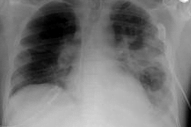In 2011, pneumonia caused at least 1.3 million deaths for children under five worldwide. Pneumonia is survivable for children that are well nourished, but the threats to nourishment reveal why lung infections are influenced by an inter-dependent system of health impacts.
Beyond food shortages, the greatest risk for a child’s nutrition is diarrheal disease. A child’s growth chart should follow a rainbow-like curve as they grow taller and gain weight over time. In regions with high child mortality, a child’s growth curve all too often stops rising and begins to go flat around six months, when previously exclusively breastfed children are exposed to the water and food supplies with immature gut bacteria, resulting in bouts of diarrhea that halt weight gain.
Particulate-laden, poor air quality from indoor cook stoves and dense, urban communities gives way to opportunistic lung infections on top of the usual string of childhood viruses. The at-risk child’s now-flat line begins dipping with each lung or diarrheal infection until one of these episodes kills the child. The ultimate cause of death is marked by the last infection the child suffered, but the underlying systemic cause is an interworking relationship of nutrition and exposure.
Child mortality is the global crisis with the highest profile, but child morbidity is an even greater problem. For every child that dies, many more survive with permanent mental and physical stunting. A girl who has suffered a severe malnourishment before two will have a high risk of maternal mortality or morbidity due to her short stature and weak hip bones that can’t endure the physical stress of transitioning a fetus’ head through them in delivery. Mentally stunted young adults struggle to find work in a job market that is already difficult for young people.
Preventing childhood mortality and morbidity from pneumonia depends on community-level medical infrastructures with health workers, nurses, midwives, or doctors who can track children over time and identify a flattening growth curve. Children with repeated lung infections need family-level interventions, such as investigating the location of the family’s cook stove compared with children’s sleeping quarters. Their diets should be studied for adequate protein. A physician friend told me of an area where the children were scolded for spilling their meat sauce when they dipped their matoke (a starch) in, so they stopped eating the meat sauce for fear of scolding. A simple, cheap health worker-lead change of mealtime tradition to have the children’s matoke balled up in advance with the meat sauce dribbled into the balls increased the villages’ community-level health far beyond protein because well nourished children can survive pneumonia.
This year’s World Pneumonia Day is important because it hits just as global leaders are meeting to discuss targets for reducing child mortality post-2015 when the MDGs expire. Identifying gold standards is critical. Such a network of interconnected health workers is entirely feasible for low-income regions. Cuba’s public health-centric medical system is praised for his high life expectancies despite low incomes. There, a doctor with a patient suffering repeated lung infections is expected to visit the patient’s home to find the source of particulates or mold causing the illnesses. Rwanda credits its network of health workers—on average, at least one for every 250 people—and a highly responsive case management system with achieving the greatest reduction in childhood mortality from pneumonia in all of Sub-Saharan Africa, dropping by 6% per year from 2000 to 2010.
On World Pneumonia Day, it behooves us all to take a moment to recognize that this major killer is very much a preventable disease.

